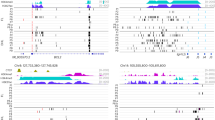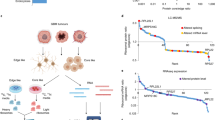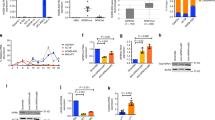Abstract
The molecular mechanism(s) linking tumorigenesis and morphological alterations in the nucleolus are presently coming into focus. The nucleolus is the cellular organelle in which the formation of ribosomal subunits occurs. Ribosomal biogenesis occurs through the transcription of ribosomal RNA (rRNA), rRNA processing and production of ribosomal proteins. An error in any of these processes may lead to deregulated cellular translation, evident in multiple cancers and ‘ribosomopathies’. Deregulated protein synthesis may be achieved through the overexpression of ribosomal proteins as seen in primary leukemic blasts with elevated levels of ribosomal proteins S11 and S14. In this study, we demonstrate that ribosomal protein S6 (RPS6) is highly expressed in primary diffuse large B-cell lymphoma (DLBCL) samples. Genetic modulation of RPS6 protein levels with specifically targeted short hairpin RNA (shRNA) lentiviruses led to a decrease in the actively proliferating population of cells compared with control shRNA. Low-dose rapamycin treatments have been shown to affect the translation of 5′ terminal oligopyrimidine (5′ TOP) tract mRNA, which encodes the translational machinery, implicating RPS6 in 5′ TOP translation. Recently, it was shown that disruption of 40S ribosomal biogenesis through specific small inhibitory RNA knockdown of RPS6 defined RPS6 as a critical regulator of 5′ TOP translation. For the first time, we show that RPS6 associates with multiple mRNAs containing a 5′ TOP tract. These findings expand our understanding of the mechanism(s) involved in ribosomal biogenesis and deregulated protein synthesis in DLBCL.
This is a preview of subscription content, access via your institution
Access options
Subscribe to this journal
Receive 50 print issues and online access
$259.00 per year
only $5.18 per issue
Buy this article
- Purchase on Springer Link
- Instant access to full article PDF
Prices may be subject to local taxes which are calculated during checkout





Similar content being viewed by others
References
Avni D, Biberman Y, Meyuhas O . (1997). The 5′ terminal oligopyrimidine tract confers translational control on TOP mRNAs in a cell type- and sequence context-dependent manner. Nucleic Acids Res 25: 995–1001.
Badis G, Saveanu C, Fromont-Racine M, Jacquier A . (2004). Targeted mRNA degradation by deadenylation-independent decapping. Mol Cell 15: 5–15.
Dai B, Kim O, Xie Y, Guo Z, Xu K, Wang B et al. (2006). Tyrosine kinase Etk/BMX is up-regulated in human prostate cancer and its overexpression induces prostate intraepithelial neoplasia in mouse. Cancer Res 66: 8058–8064.
Draptchinskaia N, Gustavsson P, Andersson B, Pettersson M, Willig TN, Dianzani I et al. (1999). The gene encoding ribosomal protein S19 is mutated in Diamond-Blackfan anaemia. Nat Genet 21: 169–175.
Espinosa L, Martín M, Nicolas A, Fabre M, Navarro E . (1997). Primary sequence of the human, lysine-rich, ribosomal protein RPL38 and detection of an unusual RPL38 processed pseudogene in the promoter region of the type-1 angiotensin II receptor gene. Biochim Biophys Acta 1354: 58–64.
Fatica A, Tollervey D . (2002). Making ribosomes. Curr Opin Cell Biol 14: 313–318.
Ferrari S, Manfredini R, Tagliafico E, Rossi E, Donelli A, Torelli G et al. (1990). Noncoordinated expression of S6, S11, and S14 ribosomal protein genes in leukemic blast cells. Cancer Res 50: 5825–5828.
Fewell SW, Woolford Jr JL . (1999). Ribosomal protein S14 of Saccharomyces cerevisiae regulates its expression by binding to RPS14B pre-mRNA and to 18S rRNA. Mol Cell Biol 19: 826–834.
Franco R, Rosenfeld MG . (1990). Hormonally inducible phosphorylation of a nuclear pool of ribosomal protein S6. J Biol Chem 265: 4321–4325.
Frigerio JM, Dagorn JC, Iovanna JL . (1995). Cloning, sequencing and expression of the L5, L21, L27a, L28, S5, S9, S10 and S29 human ribosomal protein mRNAs. Biochim Biophys Acta 1262: 64–68.
Fumagalli S, Thomas G . S6 Phosphorylation and signal transduction. In: Sonenberg N, Hershey JWB and Mathews M (eds). Translational Control of Gene Expression, Vol. 39. Cold Spring Harbor Laboratory Press, 2000, pp 695–717.
Fumagalli S, Di Cara A, Neb-Gulati A, Natt F, Schwemberger S, Hall J et al (2009). Absence of nucleolar disruption after impairment of 40S ribosome biogenesis reveals an rpL11-translation-dependent mechanism of p53 induction. Nat Cell Biol 11: 501–508.
Galbán S, Martindale JL, Mazan-Mamczarz K, López de Silanes I, Fan J, Wang W et al. (2003). Influence of the RNA-binding protein HuR in pVHL-regulated p53 expression in renal carcinoma cells. Mol Cell Biol 23: 7083–7095.
Ganapathi KA, Shimamura A . (2008). Ribosomal dysfunction and inherited marrow failure. Br J Haematol 141: 376–387.
Gross T, Nischt R, Gatermann K, Swida U, Käufer NF . (1988). Primary structure of the ribosomal protein gene S6 from Schizosaccharomyces pombe. Curr Genet 13: 57–63.
Iadevaia V, Caldarola S, Tino E, Amaldi F, Loreni F . (2008). All translation elongation factors and the e, f, and h subunits of translation initiation factor 3 are encoded by 5′-terminal oligopyrimidine (TOP) mRNAs. RNA 14: 1730–1736.
Jefferies HB, Reinhard C, Kozma SC, Thomas G . (1994). Rapamycin selectively represses translation of the ‘polypyrimidine tract’ mRNA family. Proc Natl Acad Sci USA 91: 4441–4445.
Jefferies HB, Fumagalli S, Dennis PB, Reinhard C, Pearson RB, Thomas G . (1997). Rapamycin suppresses 5′ TOP mRNA translation through inhibition of p70s6k. EMBO J 16: 3693–3704.
Kapasi P, Chaudhuri S, Vyas K, Baus D, Komar AA, Fox PL et al. (2007). L13a blocks 48S assembly: role of a general initiation factor in mRNA-specific translational control. Mol Cell 25: 113–126.
Koduru PR, Raju K, Vadmal V, Menezes G, Shah S, Susin M et al. (1997). Correlation between mutation in P53, p53 expression, cytogenetics, histologic type, and survival in patients with B-cell non-Hodgkin's lymphoma. Blood 90: 4078–4091.
Kondoh N, Shuda M, Tanaka K, Wakatsuki T, Hada A, Yamamoto M . (2001). Enhanced expression of S8, L12, L23a, L27 and L30 ribosomal protein mRNAs in human hepatocellular carcinoma. Anticancer Res 21: 2429–2433.
Law PT, Tsui SK, Lam WY, Luk SC, Hwang DM, Liew CC et al. (1996). A novel cDNA encoding a human homologue of ribosomal protein L29. Biochim Biophys Acta 1305: 105–108.
Lee-Fruman KK, Kuo CJ, Lippincott J, Terada N, Blenis J . (1999). Characterization of S6K2, a novel kinase homologous to S6K1. Oncogene 18: 5108–5114.
Lerner RS, Seiser RM, Zheng T, Lager PJ, Reedy MC, Keene JD et al. (2003). Partitioning and translation of mRNAs encoding soluble proteins on membrane-bound ribosomes. RNA 9: 1123–1137.
Levy S, Avni D, Hariharan N, Perry RP, Meyuhas O . (1991). Oligopyrimidine tract at the 5′ end of mammalian ribosomal protein mRNAs is required for their translational control. Proc Natl Acad Sci USA 88: 3319–3323.
Mazan-Mamczarz K, Hagner PR, Corl S, Srikantan S, Wood WH, Becker KG et al. (2008). Post-transcriptional gene regulation by HuR promotes a more tumorigenic phenotype. Oncogene 27: 6151–6163.
Meyuhas O . (2000). Synthesis of the translational apparatus is regulated at the translational level. Eur J Biochem 267: 6321–6330.
Mitrovich QM, Anderson P . (2000). Unproductively spliced ribosomal protein mRNAs are natural targets of mRNA surveillance in C. Elegans Genes Dev 14: 2173–2184.
Nakamura JL, Garcia E, Pieper RO . (2008). S6K1 plays a key role in glial transformation. Cancer Res 68: 6516–6523.
Nygård O, Nilsson L . (1990). Translational dynamics. Interactions between the translational factors, tRNA and ribosomes during eukaryotic protein synthesis. Eur J Biochem 191: 1–17.
Ofir-Rosenfeld Y, Boggs K, Michael D, Kastan MB, Oren M . (2008). Mdm2 regulates p53 mRNA translation through inhibitory interactions with ribosomal protein L26. Mol Cell 32: 180–189.
Patursky-Polischuk I, Stolovich-Rain M, Hausner-Hanochi M, Kasir J, Cybulski N, Avruch J et al. (2009). The TSC-mTOR pathway mediates translational activation of TOP mRNAs by insulin largely in a raptor- or rictor-independent manner. Mol Cell Biol 29: 640–649.
Pende M, Um SH, Mieulet V, Sticker M, Goss VL, Mestan J et al. (2004). S6K1(−/−)/S6K2(−/−) mice exhibit perinatal lethality and rapamycin-sensitive 5′-terminal oligopyrimidine mRNA translation and reveal a mitogen-activated protein kinase-dependent S6 kinase pathway. Mol Cell Biol 24: 3112–3124.
Perry RP . (2007). Balanced production of ribosomal proteins. Gene 401: 1–3.
Pianese G . (1896). Beitrag zur histologie und aetiologie der carcinoma. histologische und experimentelle untersuchungen. Beitr Pathol Anat Allgem Pathol 142: 1–193.
Reinert LS, Shi B, Nandi S, Mazan-Mamczarz K, Vitolo M, Bachman KE et al. (2006). MCT-1 protein interacts with the cap complex and modulates messenger RNA translational profiles. Cancer Res 66: 8994–9001.
Rommens JM, Durocher F, McArthur J, Tonin P, LeBlanc JF, Allen T et al. (1995). Generation of a transcription map at the HSD17B locus centromeric to BRCA1 at 17q21. Genomics 28: 530–542.
Ruggero D, Grisendi S, Piazza F, Rego E, Mari F, Rao PH et al. (2003a). Dyskeratosis congenita and cancer in mice deficient in ribosomal RNA modification. Science 299: 259–262.
Ruggero D, Pandolfi PP . (2003b). Does the ribosome translate cancer? Nat Rev Cancer 3: 179–192.
Ruvinsky I, Sharon N, Lerer T, Cohen H, Stolovich-Rain M, Nir T et al. (2005). Ribosomal protein S6 phosphorylation is a determinant of cell size and glucose homeostasis. Genes Dev 19: 2199–2211.
Ruvinsky I, Katz M, Dreazen A, Gielchinsky Y, Saada A, Freedman N et al. (2009). Mice deficient in ribosomal protein S6 phosphorylation suffer from muscle weakness that reflects a growth defect and energy deficit. PLoS One 4: e5618.
Sánchez-Beato M, Sánchez-Aguilera A, Piris MA . (2003). Cell cycle deregulation in B-cell lymphomas. Blood 101: 1220–1235.
Stolovich M, Tang H, Hornstein E, Levy G, Cohen R, Bae SS et al. (2002). Transduction of growth or mitogenic signals into translational activation of TOP mRNAs is fully reliant on the phosphatidylinositol 3-kinase-mediated pathway but requires neither S6K1 nor rpS6 phosphorylation. Mol Cell Biol 22: 8101–8113.
Takagi M, Absalon MJ, McLure KG, Kastan MB . (2005). Regulation of p53 translation and induction after DNA damage by ribosomal protein L26 and nucleolin. Cell 123: 49–63.
Vladimirov SN, Ivanov AV, Karpova GG, Musolyamov AK, Egorov TA, Thiede B et al. (1996). Characterization of the human small-ribosomal-subunit proteins by N-terminal and internal sequencing, and mass spectrometry. Eur J Biochem 239: 144–149.
Warner JR . (1999). The economics of ribosome biosynthesis in yeast. Trends Biochem Sci 24: 437–440.
Watson KL, Konrad KD, Woods DF, Bryant PJ . (1992). Drosophila homolog of the human S6 ribosomal protein is required for tumor suppression in the hematopoietic system. Proc Natl Acad Sci USA 89: 11302–11306.
Acknowledgements
The WT-RPS16-hGH and Cm5-RPS16-hGH constructs that contain the coding region of hGH fused to the first 29 nucleotides of the RPS16 5′ untranslated region (WT-RPS16-hGH) or to the mutant in which five of the eight pyrimidines within the 5′ TOP have been mutated to purines (Cm5) were kindly provided by the laboratories of Dr Oded Meyuhas and Dr George Thomas, This work was funded in part by a Merit Review Award from the Department of Veterans Affairs (RBG) and R01AA017972 from the National Institutes of Health (RBG).
Contributions: PRH performed the research, analyzed the data and wrote the paper. KMM performed the research, analyzed the data and wrote the paper. EMB, SSM and XFZ analyzed the data. SC performed the research. BD performed the research and analyzed the data. RBG conceived of and designed the research, analyzed the data and wrote the paper.
Author information
Authors and Affiliations
Corresponding author
Ethics declarations
Competing interests
The authors declare no conflict of interest.
Additional information
Supplementary Information accompanies the paper on the Oncogene website
Rights and permissions
About this article
Cite this article
Hagner, P., Mazan-Mamczarz, K., Dai, B. et al. Ribosomal protein S6 is highly expressed in non-Hodgkin lymphoma and associates with mRNA containing a 5′ terminal oligopyrimidine tract. Oncogene 30, 1531–1541 (2011). https://doi.org/10.1038/onc.2010.533
Received:
Revised:
Accepted:
Published:
Issue Date:
DOI: https://doi.org/10.1038/onc.2010.533
Keywords
This article is cited by
-
Ribosomal proteins induce stem cell-like characteristics in glioma cells as an “extra-ribosomal function”
Brain Tumor Pathology (2022)
-
DRAM1 regulates autophagy and cell proliferation via inhibition of the phosphoinositide 3-kinase-Akt-mTOR-ribosomal protein S6 pathway
Cell Communication and Signaling (2019)
-
Ribosomal proteins: insight into molecular roles and functions in hepatocellular carcinoma
Oncogene (2018)
-
Translation inhibition and stress granules in the antiviral immune response
Nature Reviews Immunology (2017)
-
Highly expressed ribosomal protein L34 indicates poor prognosis in osteosarcoma and its knockdown suppresses osteosarcoma proliferation probably through translational control
Scientific Reports (2016)



